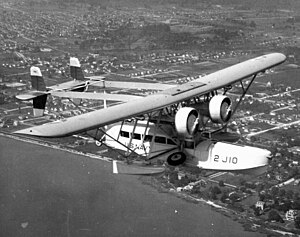
Summary
The Sikorsky S-41 was an amphibious flying boat airliner produced in the United States in the early 1930s.[1] Essentially a scaled-up monoplane version of the Sikorsky S-38 biplane flying boat,[1] Pan Am operated the type on routes in the Caribbean, South America, and between Boston and Halifax.[1]
| S-41 | |
|---|---|

| |
| A U.S. Navy RS-1 in the early 1930s | |
| Role | Airliner |
| National origin | United States |
| Manufacturer | Sikorsky Aircraft |
| First flight | 1930[1] |
| Primary users | Pan Am United States Navy |
| Number built | 7[1] |
| Developed from | Sikorsky S-38 |
Development edit
The S-41 had a parasol wing configuration, with two radial engines mounted on struts between the fuselage and the wing.[1] The cabin was completely enclosed within the all-metal hull[1] and could seat 15 passengers.[2][3]
The United States Navy purchased three examples and designated them RS-1;[3][4] these were joined by two Pan Am aircraft pressed into Navy service and designated RS-5.[5][6]
Variants edit
Operators edit
Accidents and incidents edit
- On 27 August 1931, A Sikorsky S-41, NC41V of Boston-Maine Airways crash landed in while making the run between Halifax (N.S.) and Boston (MA).[9] After clinging to the sides of a partially inflated life raft in rough seas for two hours, the 12 survivors were rescued by the F/V Nova Julia, a mackerel seiner out of Gloucester MA, captained by Capt. Leo Favaloro. There was one fatality. Seventy-year-old Edward Bamwell was assumed trapped in the wreckage as it disappeared beneath the waves just a moment after he gallantly allowed one of the three women passengers to precede him to the waiting raft. The Sikorsky had only been in service one month. Heavy fog was cited as the cause of the crash.[10][11] The S-41 was repaired and reregistered as NC60V.[12]
- On 28 October 1931, Col Thomas C. Turner, Chief of the Aviation Section of the United States Marine Corps, flew as a passenger in a Sikorsky RS-1 to Port-au-Prince, Haiti.[13][14] After arrival, the aircraft became stuck in the sand; when he got out to inspect it, he was struck in the head by one of its propellers.[14][15] He died from his injuries two days later.[13][14][15]
Specifications (S-41A) edit
Data from Jane's all the World's Aircraft 1931,[16] U.S. commercial aircraft[1]
General characteristics
- Crew: 2
- Capacity: fifteen
- Length: 45 ft 2 in (13.77 m)
- Wingspan: 78 ft 9.25 in (24.0094 m)
- Wing area: 729 sq ft (67.7 m2) on wheels
- Airfoil: Sikorsky GSM[17]
- Empty weight: 8,100 lb (3,674 kg)
- Gross weight: 13,800 lb (6,260 kg)
- Fuel capacity: 520 US gal (430 imp gal; 2,000 L) maximum (2,400 lb (1,100 kg) fuel and oil)
- Powerplant: 2 × Pratt & Whitney R-1860 Hornet B 9-cylinder air-cooled radial piston engines, 575 hp (429 kW) each
- Propellers: 2-bladed metal propellers
Performance
- Maximum speed: 131 mph (211 km/h, 114 kn)
- Cruise speed: 113 mph (182 km/h, 98 kn)
- Alighting speed: 66 mph (57 kn; 106 km/h)
- Range: 920 mi (1,480 km, 800 nmi)
- Service ceiling: 18,210 ft (5,550 m)
- Rate of climb: 875 ft/min (4.45 m/s)
- Wing loading: 18.93 lb/sq ft (92.4 kg/m2)
- Power/mass: 12 lb/hp (7.3 kg/kW)
See also edit
Related development
References edit
- Notes
- ^ a b c d e f g h i j Munson pp 52, 212
- ^ a b Taylor 1989, p.810
- ^ a b c The Illustrated Encyclopedia of Aircraft, p.2932
- ^ Grossnick 1995, 529
- ^ Grossnick 1995, 542
- ^ the Navy applied the designations RS-2, RS-3, and RS-4 to other models of Sikorsky flying boats; refer to Grossnick 1995, p.530 and p.542 and Andrade 1979, p. 218.
- ^ a b c Aerofiles
- ^ a b Andrade 1979, p. 218
- ^ "Logbook Magazine". Archived from the original on 2015-07-29. Retrieved 2015-05-12.
- ^ 28 Aug 1931 Gloucester Daily Times
- ^ 26 June 1999 Hartford Courant. Obituary of Alfred Esten
- ^ United States Civil Aircraft Register http://www.airhistory.org.uk/gy/reg_N32.html
- ^ a b Elliott & Gillespie 1975, p.14
- ^ a b c Elliott 1977, p.15
- ^ a b New York Times 29 October 1931, p.21
- ^ Grey p314c
- ^ Lednicer, David. "The Incomplete Guide to Airfoil Usage". m-selig.ae.illinois.edu. Retrieved 16 April 2019.
- Bibliography
- Andrade, John (1979). U.S. Military Aircraft Designations and Serials since 1909. Hinckley, Leicestershire: Midland Counties Publications.
- "Colonel T. C. Turner of Marines is Dead". New York Times: 21. 29 October 1931. Retrieved 2010-02-18. (payment required to view full article)
- Elliott, John M.; Clyde W. Gillespie (May 1975). "MCAS Quantico" (PDF). Naval Aviation News: 9–15. Retrieved 2010-02-18.
- Elliott, John M. (May 1977). "Early Marine Corps Aviators" (PDF). Naval Aviation News: 14–16. Retrieved 2013-12-11.
- Grossnick, Roy A. (1995). United States Naval Aviation 1910–1995. Washington, D.C.: Naval Historical Center.
- The Illustrated Encyclopedia of Aircraft. London: Aerospace Publishing. p. 2932.
- Munson, Kenneth (1982). U.S. commercial aircraft. London: Jane's. pp. 52, 212. ISBN 9780710601209.
- "Sikorsky". Aerofiles. 29 April 2009. Retrieved 2010-02-18.
- Taylor, Michael J. H. (1989). Jane's Encyclopedia of Aviation. London: Studio Editions. p. 810.
- Grey, C.G., ed. (1931). Jane's all the World's Aircraft 1931. London: Sampson Low, Marston & company, ltd. p. 314c.


